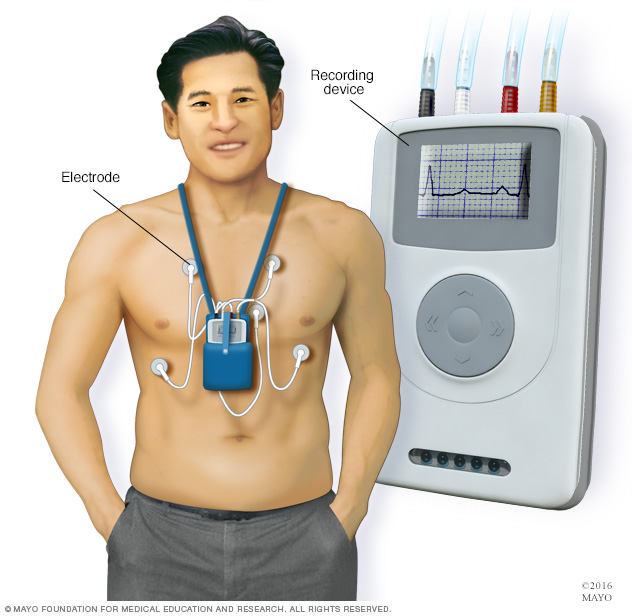Table of contents
Overview
A Holter monitor is a small, wearable device that keeps track of your heart rhythm. Your doctor may want you to wear a Holter monitor for one to two days. During that time, the device records all of your heartbeats.
A Holter monitor test is usually performed after a traditional test to check your heart rhythm (electrocardiogram), especially if the electrocardiogram doesn’t give your doctor enough information about your heart’s condition.
Your doctor uses information captured on the Holter monitor to figure out if you have a heart rhythm problem.
While wearing a Holter monitor may be a little inconvenient, it’s an important test that may help your doctor diagnose your condition.
Why it’s done
If you have signs or symptoms of a heart problem, such as an irregular heartbeat (arrhythmia) or unexplained fainting, your doctor may order a test called an electrocardiogram. An electrocardiogram is a brief, noninvasive test that uses electrodes taped to your chest to check your heart’s rhythm.
However, sometimes an electrocardiogram doesn’t detect any irregularities in your heart rhythm because you’re hooked up to the machine for only a short time. If your signs and symptoms suggest that an occasionally irregular heart rhythm may be causing your condition, your doctor may recommend that you wear a Holter monitor for a day or so.
Over that time, the Holter monitor may be able to detect irregularities in your heart rhythm that an electrocardiogram couldn’t detect.
Your doctor may also order a Holter monitor if you have a heart condition that increases your risk of an abnormal heart rhythm. Your doctor may suggest you wear a Holter monitor for a day or two, even if you haven’t had any symptoms of an abnormal heartbeat.
Risks
There are no significant risks involved in wearing a Holter monitor other than possible discomfort or skin irritation where the electrodes were placed.
However, the Holter monitor can’t get wet, or it will be damaged. Do not swim or bathe for the entire time you’re wearing your Holter monitor.
Holter monitors are not usually affected by other electrical appliances. But avoid metal detectors, magnets, microwave ovens, electric blankets, and electric razors and toothbrushes while wearing one because these devices can interrupt the signal from the electrodes to the Holter monitor. Also, keep your mobile phones and portable music players at least 15 centimetres from the monitor for the same reason.
How you prepare

If your doctor recommends Holter monitoring, you’ll have the device placed during a scheduled appointment. Unless your doctor tells you otherwise, plan to bathe before this appointment. Most monitors can’t be removed and must be kept dry once monitoring begins.
A nurse will place 4-cm diameter electrodes that sense your heartbeat on your chest. For men, a small amount of hair may be shaved to make sure the electrodes stick.
The nurse will then connect the electrode to a recording device with several wires and will instruct you on how to properly wear the recording device so that it can record data transmitted from the electrodes. The recording device is about the size of a deck of cards.
Once your monitor is fitted and you’ve received instructions on how to wear it, you can leave your doctor’s office and resume your normal activities.
What you can expect
During the procedure
Holter monitoring is painless and non-invasive. You can hide the electrodes and wires under your clothes, and you can wear the recording device on your belt or attached to a strap. Once your monitoring begins, don’t take the Holter monitor off — you must wear it at all times, even while you sleep.
While you wear a Holter monitor, you can carry out your usual daily activities. Your doctor will tell you how long you’ll need to wear the monitor. It may vary from 24 to 48 hours, depending on what condition your doctor suspects you have or how frequently you have symptoms of a heart problem.
You will be instructed to keep a diary of all the activities you do while wearing the monitor. It’s particularly important to record in the diary any symptoms of palpitations, skipped heartbeats, shortness of breath, chest pain or dizziness. You will be given a form to help you record your activities and any symptoms.
Your doctor can compare data from the Holter monitor recorder with your diary, which can help diagnose your condition.
After the procedure
Once your monitoring period is over, you will return the device to your doctor’s office, along with the diary you kept while you wore the Holter monitor. Your doctor will compare the data from the recorder and the activities and symptoms you wrote down.
Results
After your doctor has looked at the results of the Holter monitor recorder and what you’ve written in your activity diary, he or she will talk to you about your results. The information from the Holter monitor may reveal that you have a heart condition, or your doctor may need more tests to find out what may be causing your symptoms.
In some cases, your doctor may not be able to diagnose your condition based on the results of the Holter monitor test, especially if you didn’t have any irregular heart rhythms while you wore the monitor.
Your doctor may then recommend long-term heart rhythm monitoring by an implantable loop recorder (a small device inserted just beneath the skin of the chest) which can record your heart rhythm continuously for up to three years and capture information that a standard electrocardiogram or Holter monitor misses because some heart rhythm abnormalities occur infrequently.



